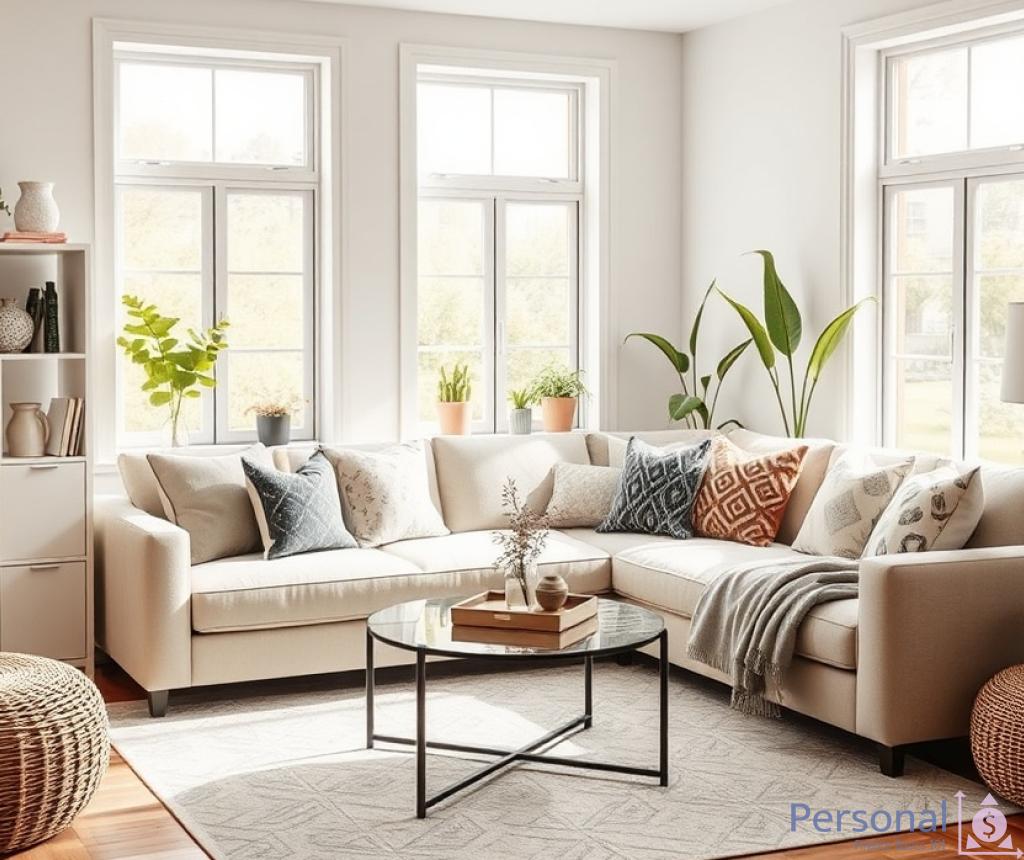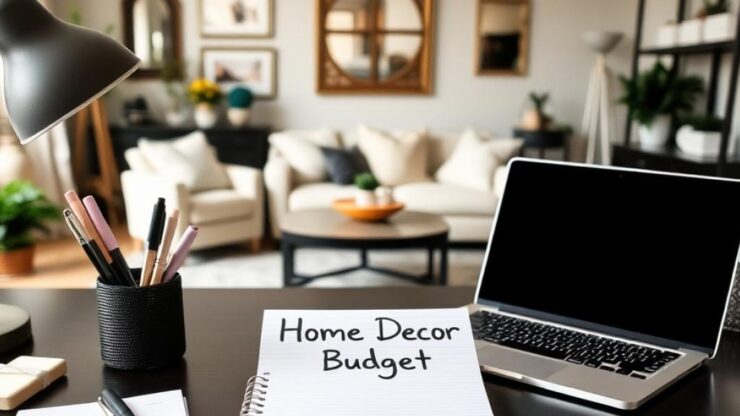Assessing Your Home Decor Needs

Before diving into the world of home decor, it’s essential to evaluate the specific needs of your space. Each room in your home serves a different function, and understanding how you utilize these spaces can help you prioritize your decorating efforts. Consider the activities that take place in each room, the amount of natural light, and any existing furniture that you plan to keep.
Once you have a clear understanding of your space, the next step is to identify your priorities and style preferences. This involves asking yourself which rooms require immediate attention and how you envision each space looking. Are you drawn to modern minimalism, rustic charm, or perhaps a vintage aesthetic? Documenting your style inspirations can provide clarity as you make decisions on furnishings and decor elements.
After assessing your space and style, creating a budget is crucial. Developing a budgeting strategy allows you to allocate funds effectively without overspending. Below is a comprehensive list of steps to consider when budgeting for your home decor:
- Evaluate your financial situation: Determine how much you can realistically spend.
- Set clear goals: Identify which areas of your home need the most attention and prioritize them.
- Research costs: Look up average prices for furniture, decor, and materials that fit your style.
- Make a list of essential items: Identify must-haves versus nice-to-haves.
- Allocate funds: Distribute your budget across rooms and items based on importance.
- Track your spending: Keep a record of purchases to ensure you stay within budget.
By following these steps, you can develop a realistic budget that meets your home decor needs while also aligning with your financial goals. Remember, the key to successful home decorating is thoughtful planning and execution.
Setting a Realistic Budget
Establishing a budget for your home decor is a pivotal step that sets the foundation for a successful decorating project. A realistic budget not only helps you manage your finances efficiently, but it also allows you to make informed decisions that align with your aesthetic vision. To ensure that your budget is both achievable and effective, it’s important to consider several key factors that can influence your spending.
Evaluate Your Priorities: Begin by assessing which areas of your home require immediate attention. Prioritizing your needs will help streamline your budgeting process. If you find that the living room is in dire need of an update, while other rooms can wait, focus your resources accordingly. This strategic approach will not only help you allocate your budget wisely but also ensure that your most-used spaces reflect your style and comfort.
Research and Compare Costs: Once you have established your priorities, the next step is to conduct thorough research on the costs associated with your desired decor elements. Visit showrooms, browse online stores, and check local classifieds to gather a range of prices for furniture, artwork, and accessories. By comparing the costs, you can identify which items fit your budget and where you might need to make adjustments. Additionally, consider looking for sales or discounts that can help stretch your budget further.
Flexibility is Key: While it’s important to stick to your budget, being flexible can lead to unexpected opportunities. Sometimes, you may come across a stunning piece that you hadn’t initially considered, or a high-quality item that’s available at a discount. Being open to adjusting your budget slightly allows you to take advantage of such opportunities without compromising your overall financial plan.
| Decor Item | Estimated Cost | Budget Allocation |
|---|---|---|
| Living Room Sofa | $800 | $700 |
| Dining Table | $500 | $400 |
| Wall Art | $200 | $150 |
In conclusion, setting a realistic budget for your home decor requires careful consideration and strategic planning. It’s essential to evaluate your priorities, research costs thoroughly, and remain flexible in your approach. By following these principles, you can create a beautiful living space that reflects your style while ensuring that you stay within your financial means.
Prioritizing Decor Purchases
When embarking on a home decor project, the excitement of transforming your space can sometimes cloud judgment about where to invest your budget. Prioritizing decor purchases is crucial in ensuring that your funds are allocated effectively, leading to a cohesive and aesthetically pleasing environment. By identifying the most impactful items and areas in your home, you can achieve a stunning decor that resonates with your personal style.
Before making any purchases, take the time to evaluate which areas of your home require the most attention. High-traffic spaces such as the living room, kitchen, and dining areas often serve as the heart of the home and can benefit significantly from thoughtful decor. Start by listing these key areas and consider the following:
- Functionality: Determine how each room is utilized and what decor elements would enhance its use.
- Visual Appeal: Identify focal points in each space that could be emphasized with decor.
- Current Condition: Assess existing furniture and decor for wear and outdated styles that may need replacement.
Once you have identified the important areas in your home, the next step is to create a priority list of decor items. This list will serve as a roadmap for your decor journey, helping you focus on what truly matters. Below is an example list that outlines essential categories and potential purchases:
| Decor Category | Priority Level | Estimated Cost |
|---|---|---|
| Sofa | High | $800 |
| Dining Table | Medium | $500 |
| Accent Chairs | Medium | $300 |
| Wall Art | Low | $150 |
| Rug | Medium | $250 |
This table illustrates how you can categorize your purchases based on their necessity and impact. By focusing on high-priority items first, you can ensure that your budget is directed towards pieces that will enhance your living spaces the most.
As you begin to make purchases, remember that informed decision-making is key. Research various retailers, compare prices, and consider the quality of items before committing to a purchase. It’s also wise to keep an eye out for seasonal sales and discounts that can provide opportunities to acquire high-quality decor at reduced prices. By staying organized and focused on your priority list, you can successfully transform your home while adhering to your budget.
Finding Affordable Decor Options
In the quest to transform your home into a stylish sanctuary, the challenge of finding affordable decor options can often feel daunting. However, with a strategic approach, you can discover a plethora of budget-friendly choices that do not compromise on style or quality. The key lies in exploring various avenues and being open to creativity. By thinking outside the box, you can find decor pieces that elevate your space while keeping your finances in check.
One of the most effective ways to unearth affordable decor options is by broadening your search beyond traditional retail stores. Online marketplaces, thrift shops, and local flea markets can be treasure troves for unique finds. Online platforms such as Etsy and eBay often feature handmade or vintage items at competitive prices, while second-hand stores can provide high-quality pieces at a fraction of the original cost. Engaging in this exploratory phase not only allows you to save money but also helps you discover one-of-a-kind items that reflect your personal style.
Another excellent way to achieve a stunning decor without breaking the bank is by embracing do-it-yourself (DIY) projects. Whether it’s refurbishing old furniture, crafting your own wall art, or creating decorative accessories, DIY projects can add a personal touch to your home. Investing time in DIY can yield significant savings and provide a sense of accomplishment. Moreover, platforms like Pinterest and YouTube are brimming with tutorials that can guide you through various projects, making the process both enjoyable and economical.
Moreover, don’t underestimate the power of a fresh coat of paint or clever rearrangement of existing furniture. Sometimes, a simple change can breathe new life into a space without the need for additional purchases. By being resourceful and adopting a hands-on approach, you can curate a home decor aesthetic that is both affordable and uniquely yours.
Tracking Expenses and Adjusting the Budget
Embarking on a home decor journey is an exhilarating experience, yet it can also lead to unexpected expenses. To navigate this, tracking your spending is essential. By keeping a detailed account of all purchases related to home decor, you can ensure that you are adhering to your established budget and making informed financial decisions. This practice not only fosters financial discipline but also helps you identify areas where you may be overspending or where additional funds may be needed.
As you track your expenses, consider categorizing your purchases based on the various aspects of your home decor project. This can include furniture, accessories, paint, and renovations. By doing so, you can gain valuable insights into which areas are consuming the most funds. For instance, if you find that your spending on decor accessories is disproportionately high, it may be time to reassess your priorities and make adjustments to ensure that your budget remains balanced.
In addition to monitoring your current expenses, it is crucial to adjust your budget as needed. Life is unpredictable, and your initial budget may require flexibility due to unforeseen circumstances, such as a need for urgent repairs or an opportunity to purchase a high-quality item at a great price. By regularly reviewing your budget, you can identify areas where you can cut back or reallocate funds. This iterative process not only helps you stay within your overall financial limits but also allows you to achieve a more satisfying and cohesive decor outcome.
Ultimately, the key to successful home decor budgeting lies in maintaining an ongoing dialogue between your aspirations and your financial realities. Staying proactive about tracking your expenses and adjusting your budget empowers you to create a beautifully decorated home without compromising your financial health.
Disclaimer
This article has been created or edited with the support of artificial intelligence and is for informational purposes only. The information provided should not be considered investment advice. Please seek the support of a professional advisor before making any investment decisions.






